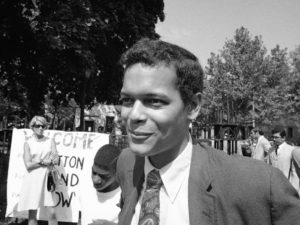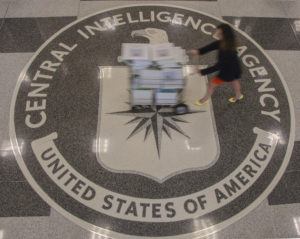The Disastrous ‘War on Terror’ Has Come Home
Jamie Garcia of the Stop LAPD Spying Coalition explores how new technologies have radically altered the way we police our major cities. Elvert Barnes / Flickr
Elvert Barnes / Flickr
Listen to Garcia’s full interview with Robert Scheer below, and beneath the audio player see a transcript of the interview.
Robert Scheer: Hi, this is Robert Scheer with another edition of “Scheer Intelligence,” where the intelligence comes from my guest. In this case it’s Jamie Garcia, who’s involved with a group called Stop LAPD Spying Coalition. And what it’s a reference to is something that has happened all over the country. The technologies launched by the CIA, by the NSA, by the Pentagon—to extensively spy on terrorists around the world and learn all these techniques of getting the terrorists in our midst and the terrorists who want to attack us—has now come to inform policing on the local community level.
Some of the estimates I’ve seen, it is highly secretive, of course, but about 50 different police departments in the United States are using the services of something called The LASER Program, which stands for, believe it or not, L.A. Strategic Extraction and Restoration. It’s basically data mining, trying to use artificial intelligence to figure out who are the bad guys are, how to do selective policing and there’s another program here in LA that’s also a national called PredPol which tries to do. … Both of these groups are basically aiming at something called predictive policing. The whole idea is to more effectively use police resources and using with data mining, the kind that use all the data we have on the Internet and to be more targeting.
The argument against it, and there’s a Dartmouth University study, many others, show that these are deeply biased studies. They involve racial profiling, they involve stigmatizing neighborhoods and they’re a self-fulfilling prophecy. That if you target people then you’ll have more arrest records, you’ll have more incidents, and that will affirm your description of these bad actors. So welcome, Jamie. Can you set us straight? How you got involved in this, what is your organization trying to do. I know you have weekly confrontations or meetings with the LAPD here in Los Angeles, so take it away.
Jamie Garcia: Yeah, thank you so much for giving us the time and to be able to inform Angelenos and talk to folks nationally about what is happening with predictive policing. So the Stop LAPD Spying Coalition, we go back to 2011 when we were formed, but we were formed primarily around an initiative called the Suspicious Activity Reporting Initiative, which is a national initiative that began in 2008. The coalition formed around that initiative, and when we think about predictive policing, I think it’s important that we see it not in a silo. We have to understand how it’s a part of the larger, national changing nature of policing, and you talk about how counter terrorism programs and counter insurgency programs are now becoming part of domestic law enforcement.
I think that’s a really important point because what we’re looking at is presumption of guilt, assigned criminality before anything happens. That concept really takes us back to post 9/11. Looking at the 9/11 Commission, where Congress really wanted to set up a way to make domestic law enforcement the eyes and ears of the federal government, So they can prevent something from happening. And I think that’s a really important concept for us to look at when we think about predictive policing because predictive policing is about data gathering. And it’s about data analysis, and it’s trying to find where that crime’s going to happen and who’s going to commit it before it actually occurs. But in some sense the Department of Justice, our federal government needed to set a landscape in order for that to occur, in order for people to buy into it. Then you mentioned this war on terror, and I think one of the guiding principles in the coalition is that there’s always an other.
That these types of policies, these type of tactics, are kind of pushed into our community because they’re looking for the terrorists, they’re looking for whatever new threat there is that we need to be fearful of. The two things I want to just kind of ground us in really quickly about the Suspicious Activity Reporting Initiative is to how they define “suspicion.” They define it as observed behavior, reasonable indicative of pre-operational planning of criminal or terrorist behavior. Now when we think about reasonable indication, what exactly does that mean? You have probable cause, you have reasonable suspicion, now you have reasonable indication which the Office of Director of National Intelligence defined as an articulable concern.
When we bring in pre-operational planning, we think of the idea that someone is thinking about doing something. So that’s essentially the kind of legal framework that the suspicious activity reporting program set up. Now after the post-9/11 commission kind of came out with this desire to stop things before they happened they passed the Intelligence Reformed Terrorism Prevention Act which mandated the president to create what’s called the information sharing environment. That was essentially an environment where data can be shared through multiple agencies – local, state, and federal law enforcement agencies.
So again now there’s the concept of data sharing, and along with data analytics. So when we ground predictive policing and those things we see that predictive policing is part of a larger architecture of surveillance. It’s part of a larger information sharing environment. So LAPD has two programs that you mentioned, PredPol and Operation LASER, which stands for LA Strategic Extraction and Restoration.
RS: Let me just stop for a minute. I mean the irony here is this is the old thing that happened with the Roman Empire, you know. You go conquer the world and you end up conquering your own people. And really, what you’re talking about is something really bizarre. You’re talking about an activity that was supposed to be aimed at getting terrorists who first of all, 15 of the 19 hijackers came from Saudi Arabia, they didn’t come from South Central LA. And you’ve got this specter of the foreign terrorists. And then you’re going to look for them in your own community. That gets conflated with gangs in LA. It gets conflated with common criminals and so forth. You end up getting all this federal money. These two programs by the way, the LASER program comes out of Palantir. People don’t know, you know, the CIA funded that organization.
Now in community after community in this country, Palantir, a CIA-funded organization. CIA is not supposed to be involved in spying within this country. Nonetheless they can start through an operation they had called In-Q-Tel and the start this group and now they’re in almost every police department including here where we’re talking about it, in Los Angeles, very secretive operation. You can’t go and observe it or anything. What are they doing? They’re mining the data collected by the 17 national intelligence agencies, the NSA, the CIA, the FBI and everything conflating it with local police reports. And they can go stop people and what they’re doing is targeting our poorest communities, communities minority, black and brown. They’re using all of this stuff that was designed to get hijackers from Saudi Arabia’s own place and they’re using it against what? 16-year-old running around South Central.
JG: Yeah, and I think that’s the interesting thing and the historical context when we think about it because before Operation LASER there was Weed and Seed. And again, LASER stands for LA Strategic Extraction and Restoration. When they talk about the program they say that there are tumors in our community that must be extracted. And with laser-like precision, like a surgeon, that they’ll extract these people or places from the community and restore the community. Well that’s nothing new. LAPD has been doing that; that was Weed and Seed. Take out the weeds and seed something new. These things have always had an intent to cause harm in the community. The thing with the LASER program is not only it’s the targeting of people, but it’s also the targeting of their homes.
That’s one thing that LAPD doesn’t talk about is that the program specifically states find these people that they target, which are called “chronic offenders.” Stop them, harass them, violate them if you can and there’s always back up chronic offenders for LAPD to use if one comes into custody or one person is pushed out of the community. Now when it comes to targeting of homes, and again I talk about the intent to cause harm is that the LASER zones that they set up through this program, within them there’s things that are called anchor points. Where they find homes that they want to target and they want to evict or work with the citywide nuisance abatement program to actually slap at state injunction and get properties turned over from owners so that the state is controlling it. Installing surveillance equipment, evicting certain individuals.
RS: If I could just stop you for a minute, I mean I just want to … There’s something so weirdly Orwellian about this and the use of language and what have you. It masks the absurdity of it. Because as far as I know there’s no evidence of gang kids or gang people in Los Angeles being hijackers of airplanes that blow up the World Trade Center. This is technology that was developed in Iraq and Afghanistan. To get ISIS, to get terrorists of, and so forth. Then somehow it’s made available to local police departments free of charge, taxpayers pay for it. Federal money goes into it and then some companies get really super wealthy. People become billionaires as a result and why are you looking at gangs in LA if you’re trying to get international terrorists? What is the connection between the Bloods the Crips and ISIS? There is no connection. What there is is a connection of the military industrial complex. You can make a lot of money saying, “Hey, we’re going to use this new technology and go after these people.”
JG: That point is really important because when Jeff Brantingham, co-creator of PredPol, when started to bring this information to create PredPol, there’s a picture that he has in a slide where he’s talking about predictive analytics. He shows a picture of Afghani men and a picture of Latino youth, side by side, one being the international terrorist, and one being what you would call a domestic terrorist. Now when we think about how we’re being policed, there was … LASER program we always say that it’s a tactic that’s old. When we think about gang injunctions and gang databases, LASER uses LASER zones and chronic offender bulletins. So very similar, but the nature of the language is changing, and I think that’s the point that’s really important because there’s been a lot of strides where people have said gang databases are harmful to people. There’s one year olds on the Cal Gang Database that have been self-proclaimed gang members that aren’t even able to speak in deciding that they’re gang members. So very flawed policing tactics.
In a way to legitimize themselves, to keep targeting the same communities that have always been targeted, black, brown, and poor communities, they have to change the language. That’s one thing that we’re really starting to uplift. For example now in schools, there’s a program called preventing violent extremism, where they’re trying to predict who will be the next possible shooter in a school. But instead of speaking in languages of like, this is a gang member, or this is going to be a problem child, they use violent extremists, which is kind of coming from that same terminology when we think about terrorists, when we think about terrorism, we think about these extremists.
So a lot of policing is changing the way that it describes itself, to sterilize itself, to make it seem like it’s race neutral, to make it seem like it’s unbiased, and data has a big role in that because most people think that data is neutral. Most people think that if it’s scientific, then it has to be right, but we have to kind of go back and look at what’s actually being criminalized, who’s actually being criminalized, and who’s collecting this data, for what purpose are they collecting this data? How is this data being used? Can these questions of community safety actually be answered through an algorithm?
I think that’s some of the bigger questions we have to ask ourselves as well, because so much technology and so much is moving with algorithms that we think it can solve every problem, but when we think about the problem of community safety, instead of the conditions that people are living under as being the problem, it’s the person and it’s the place that becomes the risk. It’s the person and the place that becomes the target. It’s the person and the place that gets extracted. Not poverty, not racism, not lack of schools, not lack of green spaces, not lack of grocery stores, none of those things become identified as the problem according to LAPD. I think those things are really important because again, it’s driving while black was predictive policing. We look at predictive policing now, and data is a proxy for race.
RS: I see it more as a racket. Now, a racket can have terrible social consequences, a lot of people end up in jail, they get racially profiled, they get killed, not going to deny that. But I see this as an extension of the military industrial complex. 9/11 opened the floodgates. The Cold War was over, we didn’t have a big enemy in the world, we were going to actually have a peace dividend, we were going to spend money on rebuilding our schools and making life better, and so forth. Then suddenly we had terrorism, and then we could get a lot of money to go fight terrorism. Then in order to spread it around, let’s get the local police departments get in. What do they do?
The money comes pouring into city after city and this becomes policing, so we don’t talk any longer about community policing, or reaching out to the community, or job training program, or inspiring youth. We don’t talk about any of that. We talk about using this high tech world of [inaudible 00:14:33] predicting who’s going to be a criminal or who’s going to be a terrorist. In a way, it’s terrorizing the community. I don’t want to dignify it by assuming this makes sense logically as a way of stopping crime. I see this as a boondoggle to spend a lot of money, and it’s a way of using that keyword that you used, “the other.” I got to take a quick break and we’ll back. I’m talking to Jamie Garcia who’s with a group called Stop LAPD Spying Coalition.
—
RS: We’re back with my guest, Jamie Garcia, [inaudible 00:15:10] “Scheer Intelligence.” So tell us more about predictive policing and what are you able to do about it. You’ve been able to get some documents, you’ve been able to file some lawsuits.
JG: Well we’re really about community building, we’re really about base building, we’re really about community empowerment. This is definitely something that can’t be resolved by an ordinance that says we want community control over surveillance. We want these programs abolished. We don’t see this doing anything productive in our community. This is a long-term fight, we definitely want predictive policing, PredPol, and LASER dismantled, but that’s on the long road towards abolition. That’s definitely a longer conversation, but what we did in May of 2017, the community came together and basically asked each other, what do we want to know about this program? We had one or two articles that let us know that LASER existed, that told us a little bit about it. So we literally all sat together, our headquarters is at Los Angeles Community Action Network, we’re based in Skid Row, so community members from Skid Row, from different areas in Los Angeles came together and wrote a public records request.
We have, it’s similar to a Freedom of Information Act, but it’s in California, so we drafted a public records request and asked for information about the LASER program. Went as far as saying we want every single chronic offender bulletin released, and that’s the secret list that LAPD has on people that they’re monitoring, tracking, and tracing through the community.
Basically LAPD responded with a couple emails saying, “Oh, give us a little time. We’re looking through documents.” Then they just went silent and decided to completely ignore us, completely ignore the community’s demand to know information. So, about eight months later we filed lawsuit in February 2018. Within two weeks of filing that lawsuit, they went around our lawyer and actually gave us documents. So at that point our conversations back and forth with the city attorney began, where they really tried to deny that at that time it was called the Smart Policing Initiative, which was the group within LAPD that was starting to operationalize the LASER program throughout the city of LA. They tried to deny that the group even existed. So we had to send them documentation from their reports that said the group existed.
We have pretty much, after about three conversations with them, have almost satiated what we wanted from the public records request. The last thing we have is the release of the chronic offender bulletins. We feel that the community has a right to know if they’re on this list, we believe this list should be released. They are not budging, so we have a court date that’s set for August of 2019, which is kind of ridiculous, but it gives us opportunities to get into the community, to actually have people in courtrooms basically saying they want this list released.
RS: Have you gotten any reaction from elected officials, be they county supervisors, be they local city people, the police board, the police commission?
JG: Well the mayor’s very much in support of this program. In fact, in his state of the city address he mentions the Community Safety Operations Centers, he mentions how predictive policing will protect people’s property. So he’s very aware. But what was-
RS: Wait a minute, let me just get this straight now. So Mayor [Eric] Garcetti, he thinks it’s great that you do predictive policing, right? Does that include doing it against people who are peace activists or civil rights activists? Members of the ACLU? Is that predictive policing? What information can we have? Where are they even situated? Where is the data being gathered?
JG: Well that’s the interesting thing, is that these Community Safety Operation Centers where they do the data analysis, and they create the lists, and they create the hot spots, they create the LASER zones, those, they’re not advertising it. They’re not telling us this is where the headquarters at, where we’re doing this data analytics. We know where LAPD’s headquarters at, but they’re definitely not advertising where the Community Safety Operation Centers are. Through the public records requests though, we are starting to receive information about where possible locations of these CSOCs are. Garcetti wants one per bureau by the end of 2019.
RS: This is a spying operation on your citizens. This is intimidating, okay? How is this list compiled? We know they have access to CIA data, to NSA data, to FBI. They are funded, I have to mention over and over again here, this LASER operation was started as a CIA operation, In-Q-Tel funded it, then Palantir grew out of that. For the first three years Palantir had only one customer, the CIA. So now here in Los Angeles, there’s this organization, Palantir, and they’re figuring out which one of us citizens here, or non-citizens, residents, are the tumor that they have to get rid of. Are they relying on NSA data or are they relying on CIA? They’re relying on police work. You have, in fact, a national police presence deciding who are the suspect citizens. What do they base it on?
We don’t know what’s in their algorithm. Is it that maybe you give a speech, or you hand out a leaflet, or you try to organize. I think this is an incredibly intimidating exercise, and what I’m asking you as a community activist, when you go see the city council members, when you go see the mayor, when you ask them, “What are you doing? Are you spying on people in this community in the name of protecting them?” What is their answer?
JG: Well, one example I can give is that the Stop LAPD Spying Coalition also had an active campaign against the drones. We collected 3,000 signatures throughout the city of LA that said no to the drones, we kept them grounded for three years, they came back. LAPD did its own community surveys out of their results, 99% of the community they surveyed said no. The Los Angeles Police Commission said, “Well, we know the community doesn’t trust the police, but we do. We’re passing this program through.” When it came up for vote in city council, when they had to finally approve the moneys for the drones, we went, we told them, “We don’t want them, here’s all the proof that the community doesn’t want them.” Again, they themselves said, “We trust the police. We are going to give them the drones.” That happened in a public safety committee, that happened in front of full city council.
That’s the reason why when we think about these kind of policies and ordinances that are starting to be pushed nationwide, saying if there’s only community control of surveillance then we’d be more protected, we would know what’s going on. But when you have your own city council not listening to the wishes of the community, you have your own police commission who’s supposed to be overseeing and in charge of the police not listening and completely going against the will of the community. You realize that there is no community control of these things. The Los Angeles Police Department will do what it wants. So I think that’s really important when we think about how we’re organizing against surveillance, and how we’re organizing against these policies and practices because I don’t think it’s something that our own city government wants to protect us from. And in fact the police commission was not even aware of the terminology of data driven evidence based policing and how it’s taken off. How the DOJ is providing grants through the Bureau of Justice Assistance to police departments like LAPD to create programs like LASER. Palantir is facilitating this process. And in fact we have spoken to other media outlets that have interviewed Palantir and they themselves say, “Well, it’s not us that’s doing this. We are just a provider of a service. It’s LAPD that’s doing this.”
And I didn’t get this information firsthand, but when I was told that this is how they are perceiving their role in this type of policing, in this type of harm that’s happening to our communities. I was completely not surprised, but realizing how people like you’re saying are just concerned about the money they’re making, not concerned about how they’re facilitating a program that’s harming the community, that has intent to come harm. I mean LASER is extracting people from the community, incarcerating them or evicting families and making it absolutely impossible for them to rent or buy a home or end up homeless. And I think people really need to realize that if they’re talking about the health and wellness of our communities, is making people homeless, especially in this time right now, the solution that we’re looking for?
RS: So we’re talking about the military-industrial complex that President Eisenhower warned us about. This is money coming from the federal government that basically redefines what local policing is all about. And Palantir [inaudible 00:23:59] responsibility because they are the ones that figure out what to look for, what data to mine, how do you mine it? How do you isolate a criminal? How do you get a judge to put a stiffer sentence on someone? How do you make someone homeless? How do you get them evicted? How do you get local police to stop people on the street?
So we are talking about the national security city, but the people designing that data mining or figuring out what’s the tumor. And we know that the FBI at one point thought Martin Luther King was the tumor and had to be eliminated. Right? So we are basically talking about a national surveillance state that now reaches down into the local community and has unlimited funding evidently and can combine all these enormous databases, federal, international, local, and target people based on a criteria they put in. Whether it’s skin color, whether it’s politics, whether it’s income or what have you. They can target them. Right?
But the real issue is we’ve accepted, and I get back to the example of the Roman Empire. They said, “Oh no, the Roman legions, they’re only going to do it outside somewhere. They’re going to do it in Iraq. They’ll do it in Afghanistan and so forth.” Now we find these weapons are developed for Afghanistan and Iraq, no, it’s now here it’s targeting. It’s profiling. It’s not going after bankers who ripped us off, they are not targeted, right? No fancy swindlers who almost destroyed the whole economy. No, it’s saying this kid or this guy, he was a member of a gang and he knew that one, but then we don’t even know what they’re doing. Maybe they’re picking up because people are politically objectionable to them because after all these local databases are merged with the CIA, NSA and everyone else’s database. Is that not the case?
JG: And that’s why I mentioned the greater architecture of surveillance. LAPD has the intelligence gathering guidelines based on one tip. LAPD can infiltrate any organization that wants to, to collect information on what’s going on there. So we’re talking about COINTELPRO tactics. I mean that are legitimized, that are practiced. I mean they can go on Facebook and create false personas and become your friend and find out information about you, gather information. There’s a long history of that kind of infiltration and that kind of disruption of movement building and I think we can even see what happened today in city hall where they passed a motion that basically any type of protest, any kind of disruption that they decide is too disruptive, you will be banned from returning to city hall. And if you do it again, you’ll be banned for three days. If you do it again, you’ll be banned for six days. So essentially it’s the criminalization of protest. So we are no longer even able to use our voices to protest these laws that are harming our communities.
RS: But you know, the irony is we’ve been there before, before high tech, before the incident, and you mentioned COINTELPRO. We know the LAPD had a red squad that went after any trade unionists, any protests, any peace person. There’s a long history of that sort of thing. However, now it’s made more ominous because you have high tech, you can get every single phone call, you can get all this data, right? That’s what this new Orwellian society is all about. This LASER program which regards some of our people living here, maybe many of them as tumors to be eradicated, that’s a nationally funded program by an organization, the CIA, that’s not supposed to be involved in our domestic lives. That’s against the law. Okay.
And yet you have these wonderful liberal folks on our city council down here in LA and our state government and everything saying, “Oh yeah, let’s do it, prevent the policing. That’s great.” No, that’s spying, that’s gathering all the information you can on the people that live here and then you single out the ones you don’t like for whatever reason. And you go after them. I’ll give you the last words, but I mean this is kind of a backwards way to do it I didn’t give you a proper introduction, but I am so inspired by this work that you’re doing. I want to know more about your story. So how’d you get into this? Let’s end on that. What motivated you? Why are you doing this? Who are you?
JG: Well, I’m a full time registered nurse. I work in the community of Boyle Heights. I started in the coalition and late 2011 towards the end of 2011 and I was actually active in The Occupy movement. I was helping to run the medical tent. The coalition did a teaching right next to the medical tent and I sat down and I started to listen in on what suspicious activity reporting is and I realized that not only was I a target, but it started to be very clear to me. And I think this is what the work of the coalition does, is it breaks down what does a police state look like. Let’s get into the specifics. Let’s talk about what they’re really doing and I think that’s what we don’t do in our communities is we don’t talk about really how is the police functioning. We just assume like a public utility that they’re doing their job, they’re providing us water or food or safety. And I think that is what will help open our eyes to how harmful policing isn’t our lives.
One thing I want to leave communities with, because I think when we hear this stuff, it becomes very overwhelming we feel kind of like how do we fight back. And one thing that we’ve been really talking about and how we fight back is the preservation of our narrative, the preservation of our story, the preservation of our lives, who we are and its entirety. And the thing that’s very misleading about data, it’s really the decontextualization of who we are by breaking us up into these little data points. There’s this assumption that neutrality, objectivity will occur. But once you break us up into data points, all the nuances that make us who we are, why we are where we’re at in our lives, where we’ve come from, where we want to be, get completely extracted or completely erased. But when in the hands of LAPD, that data gets reconstructive through the lens of criminalization.
So I leave communities with just remembering that it’s our stories that we have to preserve. It’s our stories that we have to tell. It’s our voices that have to tell those stories because that’s how we will fight back because, yes, it’s about surveillance. It’s about spying, but it’s really about trying to find a way to criminalize us. Find a way to make our lifestyles criminal, whether it’s racism, sexism, ableism, it’s how can we criminalize those things that are different? How do we take that story away and reconstruct it through a lens of criminalization? And that’s essentially what LAPD is doing.
RS: That’s it for this edition of “Scheer Intelligence.” Our producers are Joshua, Scheer and Isabel Carreon. Our engineers are Kat Yore and Mario Diaz at KCRW and here at the Annenberg School of communication and journalism it’s Sebastian Grubaugh. See you next week with another edition of “Scheer Intelligence.”
Your support is crucial…With an uncertain future and a new administration casting doubt on press freedoms, the danger is clear: The truth is at risk.
Now is the time to give. Your tax-deductible support allows us to dig deeper, delivering fearless investigative reporting and analysis that exposes what’s really happening — without compromise.
Stand with our courageous journalists. Donate today to protect a free press, uphold democracy and unearth untold stories.






You need to be a supporter to comment.
There are currently no responses to this article.
Be the first to respond.